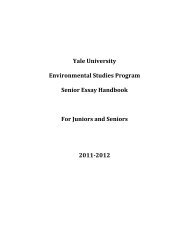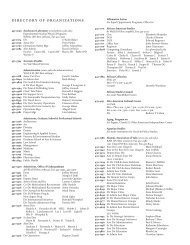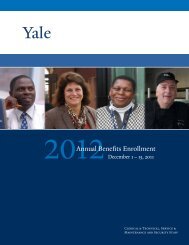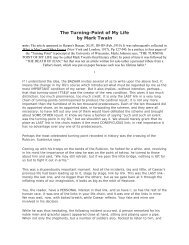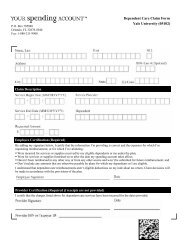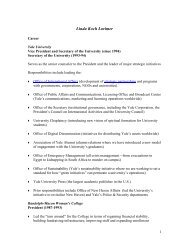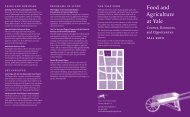Hyperspectral Vegetation Indices and Their Relationships with ...
Hyperspectral Vegetation Indices and Their Relationships with ...
Hyperspectral Vegetation Indices and Their Relationships with ...
- No tags were found...
Create successful ePaper yourself
Turn your PDF publications into a flip-book with our unique Google optimized e-Paper software.
180 Thenkabail et al.to-soil reflectance ratio, second only to 680 nm region tral narrow b<strong>and</strong> NIR <strong>and</strong> red-based indices can be computed(Fig. 8). The k 12 1025 nm represents the steep <strong>and</strong> suddenby taking: (1) very narrow b<strong>and</strong> centered at 682rise after the moisture sensitive “trough” of the NIR nm (k4 nm) for red <strong>and</strong> (2) narrow b<strong>and</strong> centered atb<strong>and</strong>, which combines <strong>with</strong> other wave b<strong>and</strong>s to provide 920 nm (k20 nm) for NIR.optimal information. However, the dark current drift in These results demonstrate that the widely used redthe spectroradiometer can affect this portion of the spectrum.<strong>and</strong> NIR b<strong>and</strong> combinations are not necessarily the bestThe NIR shoulder can be represented by a broad for two-b<strong>and</strong> NDVI type indices for estimating crop vari-b<strong>and</strong> or a narrow b<strong>and</strong> centered at 845 nm (k 9 ) to completeables. Even when red <strong>and</strong> NIR b<strong>and</strong>s are involved, theythe 12 b<strong>and</strong>s. The twelve b<strong>and</strong>s were selected often appear in unique narrow portions of the spectrumbased on their frequency of occurrence in various modelsthat are not selected by any existing satellite sensor. Forof crop variables as discussed throughout this paper. example, the index that has highest correlation for cottonThe distribution of the crop information clusters in differentWBM had b<strong>and</strong> centers at 682 nm for red <strong>and</strong> 918 nmwaveb<strong>and</strong> portions (Fig. 6) also shows an over- for NIR <strong>with</strong> b<strong>and</strong> widths varying between 20 nm to 28whelming proportion of quantitative crop information in nm. In comparison L<strong>and</strong>sat-5 TM b<strong>and</strong>s are centered atthe b<strong>and</strong> centers of these 12 b<strong>and</strong>s (Table 6). Many of 660 nm (k60 nm) for red (TM3) <strong>and</strong> at 830 nmthe optimum b<strong>and</strong>s that were selected make physical (k140 nm) for NIR (TM4). The dominant role of thesense given what we know about plant chemistry, canopy waveb<strong>and</strong> centered at 682 nm was partly due to the decreasestructure, <strong>and</strong> plant spectra (Table 6; Knipling, 1970; Elvidge,in leaf reflectance between 550 nm <strong>and</strong> 690 nm,1990). For example, 550 nm is centered over peak but is even more closely associated <strong>with</strong> the steeply risingchlorophyll reflection in the visible portion of the spectrum,soil reflectance in this range. The four-variable<strong>and</strong> 982 nm is centered over peak liquid water ab- OMNBR models performed marginally better than thesorption in the near-infrared.two-b<strong>and</strong> NDVI type models. However, the OMNBRmodels do not offer the simplicity of the two-b<strong>and</strong> NDVISUMMARY AND CONCLUSIONStype models. Also, a significant proportion of the twob<strong>and</strong>NDVI models perform nearly as well as four-variableThis research established the optimum number of hyperspectralOMNBR models. For example, the two-b<strong>and</strong> NDVIb<strong>and</strong>s, centers, <strong>and</strong> widths (Table 6) in the visi- models explained between 64% to 88% variability in differentble <strong>and</strong> near-infrared spectrum for establishing relationshipscrop variables compared to 64% to 92% variability<strong>with</strong> agricultural crop biophysical characteristics. explained by OMNBR models. Most of this variability inThis recommendation is based on the study of five crops, OMNBR models is explained using the first two to fournine growth stages, <strong>and</strong> wide ranging crop characteristics narrow b<strong>and</strong>s <strong>with</strong> addition of further b<strong>and</strong>s adding only(Table 1). A remarkably strong relationship <strong>with</strong> crop small (often, statistically insignificant) incremental invariablesis located in specific narrow b<strong>and</strong>s (Table 6) in creases in R 2 values. Additionally, it was established thatthe longer wavelength portion of the red, 650 nm to 700 when the ratio (M/N) of the number of independentnm, <strong>with</strong> secondary concentrations in the shorter wave- variables or narrow b<strong>and</strong>s (M) to that of total number oflength portion of the green, 500 nm to 550 nm, in one field samples (N) exceeds anywhere between 0.15 toparticular section of the near-infrared, 900 nm to 940 0.20, “over-fitting” of OMNBR models will be a seriousnm, <strong>and</strong> in the moisture-sensitive near-infrared, centered problem. The most frequently appearing narrow b<strong>and</strong>sat 982 nm (Fig. 6). These b<strong>and</strong> regions are followed by in the four-variable OMNBR models were (Table 3): redred-edge portion centered on 720 nm, <strong>and</strong> NIR shoulder (e.g., 682 nm), moisture-sensitive NIR (e.g., 982 nm),centered on 845 nm. An overwhelming proportion of green (e.g., 525 nm), <strong>and</strong> longer portion of NIR (920these channels had b<strong>and</strong> widths that were classified as: nm). The narrow b<strong>and</strong> models perform significantly bet-(1) very narrow (1 nm to 15 nm wide) or (2) narrow (16 ter than the broad b<strong>and</strong>s. For example, when comparednm to 30 nm wide). Most were on the order of 10 nm <strong>with</strong> TM broad b<strong>and</strong> NDVI-type models, the: (1) four-to 20 nm wide (narrow or very narrow). A rigorous pro- variable OMNBR models explained 3% to 40% additionalcedure adopted here to identify the best narrow b<strong>and</strong>variability <strong>and</strong> (2) two narrow b<strong>and</strong> NDVI-typeNDVI type models showed that the best two-b<strong>and</strong> com- models explained an additional 3% to 16% additionalbinations often involve (Tables 4 <strong>and</strong> 6, Figs. 4, <strong>and</strong> Figurevariability. The narrow b<strong>and</strong> transformed soil-adjusted5): (1) a very narrow red b<strong>and</strong> <strong>and</strong> a narrow or a vegetation index (TSAVI) models are considered the bestbroad NIR b<strong>and</strong>, or (2) a very narrow red b<strong>and</strong> <strong>and</strong> a where site specific soil lines are available, but did notvery narrow or a narrow green b<strong>and</strong>, or (3) a very narrow provide significant improvements over narrow b<strong>and</strong>red b<strong>and</strong> <strong>and</strong> a narrow b<strong>and</strong> in the moisture-sensitive NDVI models, except in one case involving potatoportion of the NIR, or (4) a very narrow red-edge b<strong>and</strong> WBM. The best derivative indices performed significantly<strong>and</strong> a narrow or broad NIR b<strong>and</strong>. The NIR <strong>and</strong> redbasedpoorer than an overwhelming proportion of theNDVI indices are most widely used in remote narrow b<strong>and</strong> NDVI, OMNBR, <strong>and</strong> even when comparedsensing. This study recommends that the best hyperspec- <strong>with</strong> most broad b<strong>and</strong> NDVI models.



